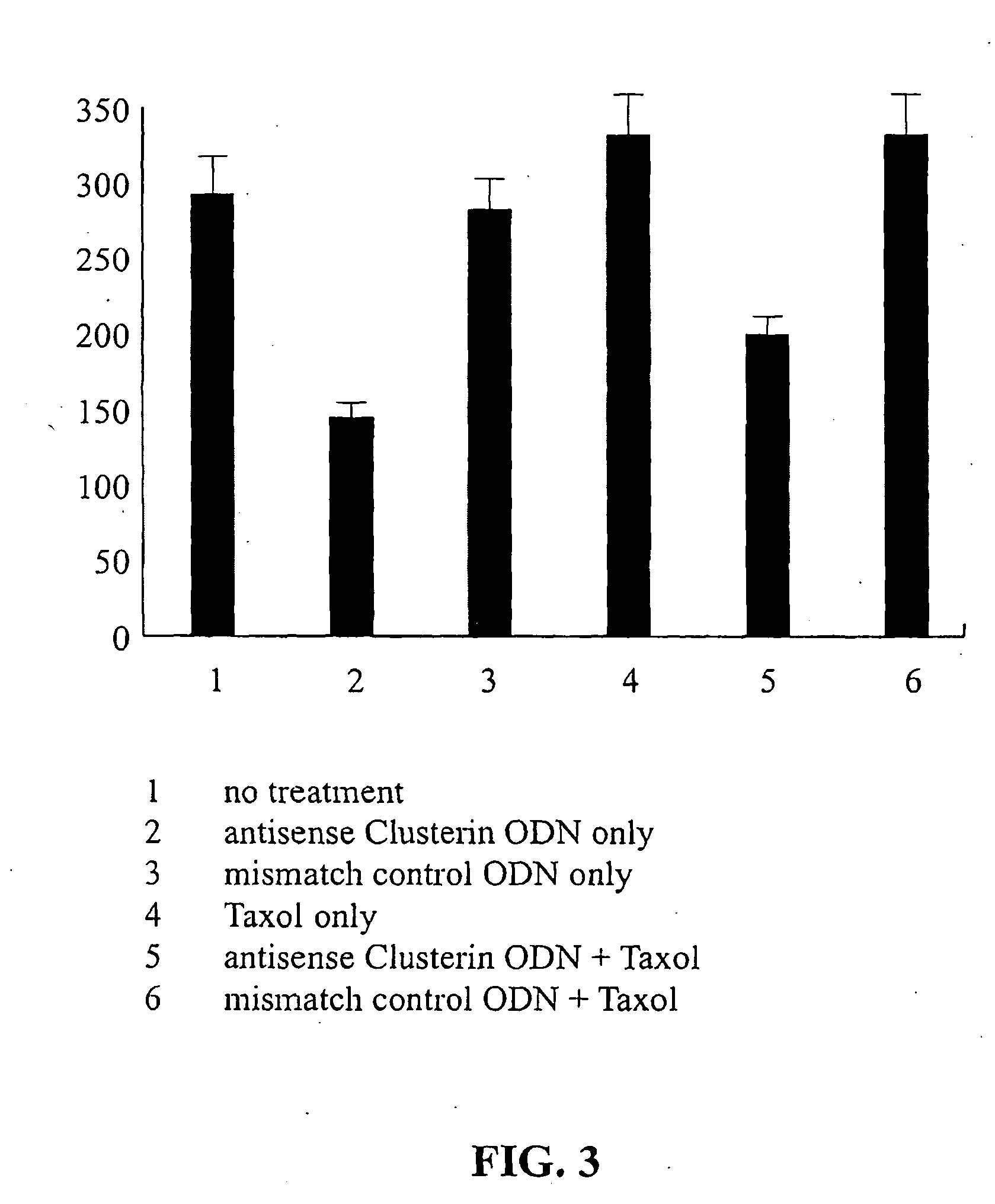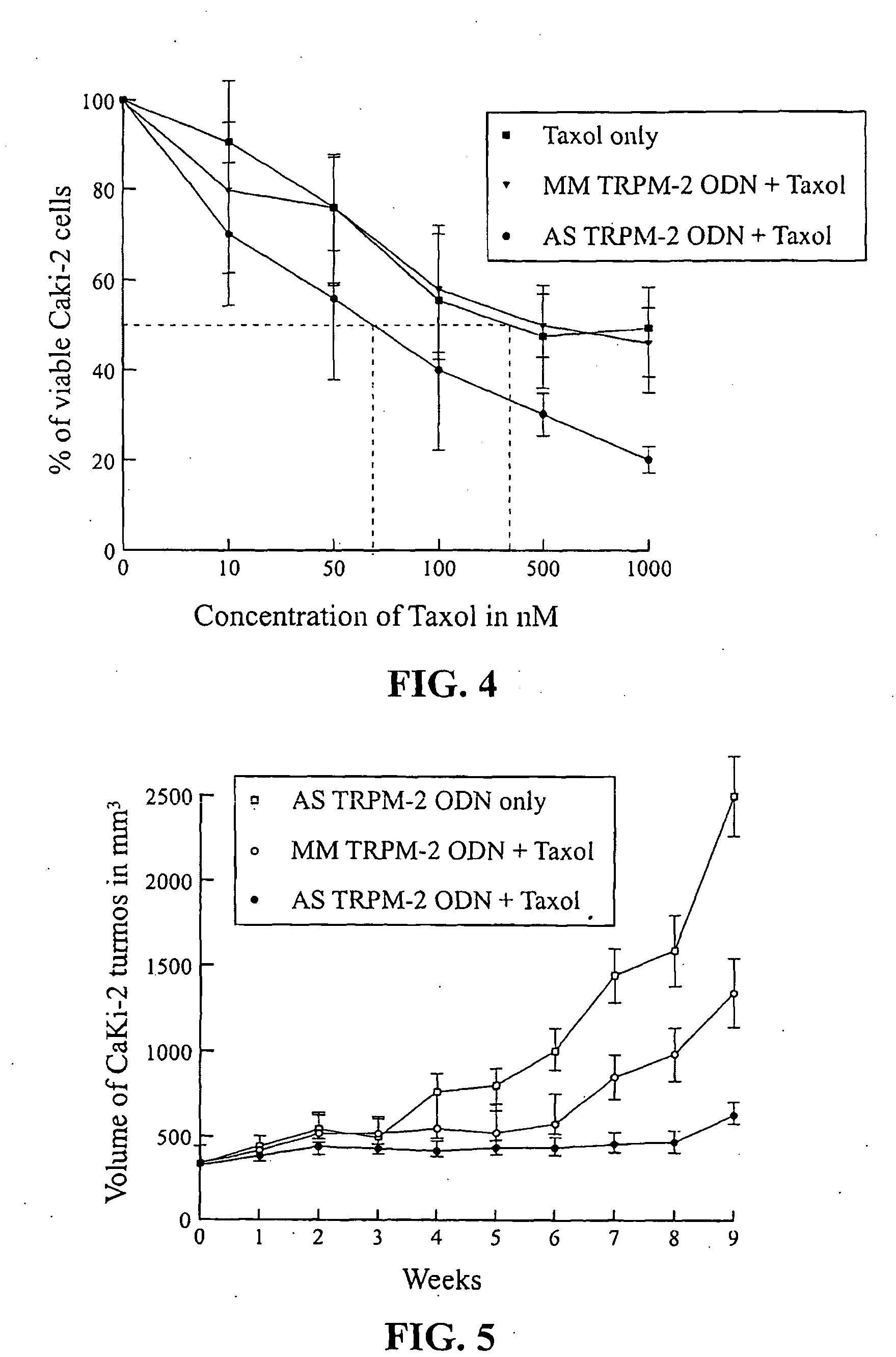Chemo- and Radiation-sensitization of Cancer by Antisense TRPM-2 Oligodeoxynucleotides
a technology of oligodeoxynucleotides and cancer cells, which is applied in the direction of drug compositions, active ingredients of phosphorous compounds, genetic material ingredients, etc., can solve the problems of side effects, dosage needs to be increased, side effects become more pronounced, etc., to enhance reduce the expression of trpm-2, and increase the sensitivity of cancer cells
- Summary
- Abstract
- Description
- Claims
- Application Information
AI Technical Summary
Benefits of technology
Problems solved by technology
Method used
Image
Examples
example 1
[0030]TRPM-2 immunostaining was performed in normal kidney and RCC tissue of 67 patients. Histological classification of RCC revealed clear cell patterns in 56 cases (84.5%), the rest of sections showing either granular cell (6%) or papillary cell patterns (9%). Staining of cytoplasmic clusterin was heterogenous in both normal and malignant tissues. Positive TRPM-2-staining was found in almost all RCC (97%) and TRPM-2-overexpression, compared to normal tissue, was observed in most RCC (69%). (Table 2) Fifty-three percent of normal kidney tissue samples (distant from RCC) showed no or only weak staining for clusterin (Table 3).
TABLE 2% of tissue stainednormal kidneyRCC 0-2550%21%25-5028%27%50-7519%30% 75-100 3%22%
TABLE 3Intensity of staining (arbitraryscoring)normal kidneyRCC017% 3%+137%12%+237%49%+3 9%22%+40 14%
example 2
[0031]The Caki-2 cell line is derived from a human clear cell carcinoma of the kidney. It was purchased from the American Type Culture Collection (Rockville, Md.). Cells were maintained in McCoy's 5a medium (Life Technologies, Inc., Gaithersburg, Md.) supplemented with 10% heat-inactivated fetal calf serum.
[0032]Phosphorothioate TRPM-2 anti sense ODN was made in accordance with the inventors instructions by La Jolla Pharmaceuticals Co. (La Jolla, Calif.). The sequence of TRPM-2 antisense ODN corresponding to the human TRPM-2 translation initiation site was 5′-CAGCAGCAGAGTCTTCATCAT-3′ (Seq. ID No. 4). A two-base TRPM-2 mismatch oligonucleotide, 5′-CAGCAGCAGAGTATTTATCAT-3′ (Seq. ID No. 15) was used as control.
[0033]Lipofectin, a cationic lipid (Life Technologies, Inc.) was used to increase oligonucleotide uptake of cells. Caki-2 cells were treated with various oligonucleotide concentrations after preincubation for 20 minutes with 20 μg / ml lipofectin in serum free OPTI-MEM (Life Techno...
example 3
[0036]Paclitaxel was purchased from Sigma Chemical Co. (St. Louis, Mo.). Stock solutions of paclitaxel were prepared with dimethyl sulfoxide (DMSO), and diluted with PBS to the required concentrations before each in vitro experiment. Polymeric micellar paclitaxel used in this study was generously supplied by Dr. Helen M. Burt (Faculty of Pharmaceutical Sciences, University of British Columbia, Vancouver, Canada), as previously reported. Leung et al., Prostate 44: 156-63 (2000).
[0037]Northern blot analysis was used to assess the effects of paclitaxel treatment on TRPM-2 mRNA expression in Caki-2 cells in vitro and tumors in vivo, respectively. As shown in FIG. 2, TRPM-2 mRNA induction increased in a dose-dependent manner after paclitaxel treatment in vitro up to 73% at concentrations of 100 nM.
[0038]To determine whether paclitaxel changes TRPM-2 mRNA expression in Caki-2 tumors in vivo, 0.5 mg polymeric micellar paclitaxel was administered intravenously once daily over 10 days with h...
PUM
| Property | Measurement | Unit |
|---|---|---|
| concentrations | aaaaa | aaaaa |
| diameter | aaaaa | aaaaa |
| volume | aaaaa | aaaaa |
Abstract
Description
Claims
Application Information
 Login to View More
Login to View More - R&D
- Intellectual Property
- Life Sciences
- Materials
- Tech Scout
- Unparalleled Data Quality
- Higher Quality Content
- 60% Fewer Hallucinations
Browse by: Latest US Patents, China's latest patents, Technical Efficacy Thesaurus, Application Domain, Technology Topic, Popular Technical Reports.
© 2025 PatSnap. All rights reserved.Legal|Privacy policy|Modern Slavery Act Transparency Statement|Sitemap|About US| Contact US: help@patsnap.com



